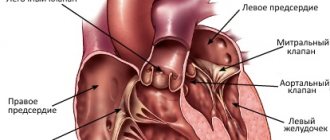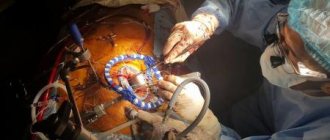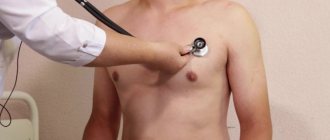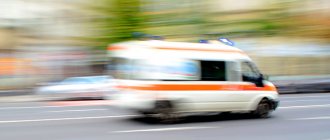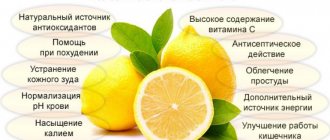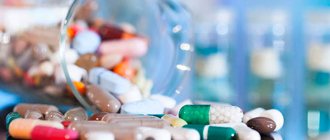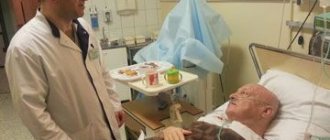The heart is a muscular pump that ensures continuous movement of blood through the vessels. Together, the heart and blood vessels make up the cardiovascular system. This system consists of the systemic and pulmonary circulation. From the left side of the heart, blood first moves through the aorta, then through large and small arteries, arterioles, and capillaries. In the capillaries, oxygen and other substances necessary for the body enter the organs and tissues, and from there carbon dioxide, metabolic products, are removed. After this, the blood turns from arterial to venous and again begins to move towards the heart. First along the venules, then through smaller and larger veins. Through the inferior and superior vena cava, blood again enters the heart, only this time into the right atrium. A large circle of blood circulation is formed.
Venous blood from the right side of the heart is sent through the pulmonary arteries to the lungs, where it is enriched with oxygen, and returns to the heart again - this is the pulmonary circulation.
Inside, the heart is divided by partitions into four chambers. The two atria are divided by the interatrial septum into the left and right atria. The left and right ventricles of the heart are separated by the interventricular septum. Normally, the left and right parts of the heart are completely separate. The atria and ventricles have different functions. The atria store blood that flows into the heart. When the volume of this blood is sufficient, it is pushed into the ventricles. And the ventricles push blood into the arteries, through which it moves throughout the body. The ventricles have to do more hard work, so the muscle layer in the ventricles is much thicker than in the atria. The atria and ventricles on each side of the heart are connected by the atrioventricular orifice. Blood moves through the heart in only one direction. In the systemic circle of blood circulation from the left side of the heart (left atrium and left ventricle) to the right, and in the small circle from the right to the left.
The correct direction of blood flow is ensured by the valve apparatus of the heart:
Valves:
- tricuspid
- pulmonary
- mitral
- aortic
They open at the right time and close, preventing blood flow in the opposite direction.
Aortic valve
Closes the entrance to the aorta. It also consists of three valves, which look like crescents. Opens when the left ventricle contracts. In this case, blood enters the aorta. When the left ventricle relaxes, it closes. Thus, venous blood (poor in oxygen) from the superior and inferior vena cava enters the right atrium. When the right atrium contracts, it moves through the tricuspid valve into the right ventricle. Contracting, the right ventricle ejects blood through the pulmonary valve into the pulmonary arteries (pulmonary circulation). Enriched with oxygen in the lungs, the blood turns into arterial blood and moves through the pulmonary veins to the left atrium, then to the left ventricle. When the left ventricle contracts, arterial blood enters the aorta through the aortic valve under high pressure and spreads throughout the body (systemic circulation).
The heart muscle is called the myocardium
There are contractile and conductive myocardium. The contractile myocardium is the actual muscle that contracts and produces the work of the heart. In order for the heart to contract in a certain rhythm, it has a unique conduction system. The electrical impulse to contract the heart muscle occurs in the sinoatrial node, which is located in the upper part of the right atrium and spreads through the conduction system of the heart, reaching every muscle fiber
First, both atria contract, then both ventricles, thereby ensuring the flow of blood to all organs and tissues of the body. The heart muscle has two membranes (external and internal). The inner lining of the heart is called the endocardium. The outer lining of the heart is called the pericardium.
Heart and blood vessels
The human cardiovascular system is closed. This means that the blood moves only through the vessels and there are no cavities into which the blood flows. Thanks to the work of the heart and the branched system of blood vessels, every cell in our body receives oxygen and nutrients that are necessary for life.
Pay attention to the established name - cardiovascular system. The first place is taken by the heart muscle, which performs the most important function. We move on to studying this unique organ.
Heart
The branch of medicine that studies the heart is called cardiology (from the ancient Greek καρδία - heart and λόγος - study). The heart is a hollow muscular organ that contracts with a certain rhythm throughout a person’s life.
The outside of the heart is covered by a pericardial sac - the pericardium. Consists of 4 chambers: 2 ventricles - right and left, and 2 atria - right and left. Remember that between the ventricles and atria there are leaflet valves.
Between the right atrium and the right ventricle there is a tricuspid (tricuspid) valve, and between the left atrium and the left ventricle there is a bicuspid (mitral) valve.
In the heart, blood moves unidirectionally: from the atria to the ventricles, thanks to the presence of leaflet (atrioventricular) valves (from the Latin atrium - atrium and ventriculus - ventricle).
The largest human vessel, the aorta, with a diameter of 2.5 cm, departs from the left ventricle, in which blood flows at a speed of 50 cm per second. The pulmonary trunk departs from the right ventricle. Between the left ventricle and the aorta, as well as the right ventricle and the pulmonary trunk, there are semilunar valves.
The muscle tissue of the heart is represented by single cells - cardiomyocytes, which have transverse striations. The heart has a special property - automaticity: isolated from the body, the heart continues to contract without external influences. This is due to the presence of special cells in the thickness of muscle tissue - pacemaker cells (pacemaker cells, atypical cardiomyocytes), which themselves periodically generate nerve impulses.
The heart has a conduction system due to which the excitation that arises in one part of the heart gradually covers other parts. The conduction system includes the sinus node, atrioventricular node, His bundle and Purkinje fibers. It is thanks to the presence of these conducting structures that the heart is capable of automation.
Cardiac cycle
The work of the heart consists of three phases successively replacing each other:
- Atrial systole (from the Greek systole - compression, contraction)
- Ventricular systole
- Total diastole (from the Greek diastole - expansion)
Lasts 0.1 sec. During this phase, the atria contract, their volume decreases, and blood flows from them into the ventricles. During this phase, the leaflet valves are open, the semilunar valves are closed.
Lasts 0.3 seconds. The leaflet (atrioventricular) valves close to prevent blood from flowing back into the atria. The muscle tissue of the ventricles begins to contract, their volume decreases: the semilunar valves open. Blood is expelled from the ventricles into the aorta (from the left ventricle) and the pulmonary trunk (from the right ventricle).
Lasts 0.4 seconds. In diastole, the cavities of the heart expand - the muscles relax, the semilunar valves close. Flap valves are open. During this phase, the atria fill with blood, which passively flows into the ventricles. Then the cycle repeats.
We have already discussed the cardiac cycle, but I want to focus your attention on some details. In total, one cycle lasts 0.8 seconds. The atria rest for 0.7 seconds during ventricular systole and total diastole, and the ventricles rest for 0.5 seconds during atrial systole and total diastole. Thanks to this energetically beneficial cycle, the heart muscle gets less tired during work.
Heart rate (HR) can be measured using the pulse - the jerky vibrations of the walls of blood vessels associated with the cardiac cycle. The normal average heart rate is 60-80 beats per minute. An athlete's heart rate is lower than that of an untrained person. With heavy physical exertion, heart rate can increase to 150 beats/min.
Changes in the heart rate are possible in the form of its excessive slowdown or increase, respectively, they are distinguished: bradycardia (from the Greek βραδυ - slow and καρδιά - heart) and tachycardia (from the ancient Greek ταχύς - fast and καρδία - heart). Bradycardia is characterized by a decrease in heart rate to 30-60 beats/min, tachycardia - above 90 beats/min.
The regulatory center of activity of the cardiovascular system lies in the medulla oblongata and spinal cord. The parasympathetic nervous system slows down and the sympathetic nervous system speeds up heart rate. Humoral factors also have an influence (from the Latin humor - moisture), mainly hormones: adrenal glands - adrenaline (strengthens the heart), thyroid gland - thyroxine (accelerates heart rate).
Vessels
Blood moves to tissues and organs inside the vessels. They are divided into arteries, veins and capillaries. We will discuss their structure and functions in general terms. I would like to note: if you think that venous blood flows through the veins and arterial blood flows through the arteries, you are mistaken. In the following article you will find specific examples that refute this misconception.
Arteries carry blood from the heart to internal organs and tissues. They have thick walls containing elastic and smooth muscle fibers. The blood pressure in them is the highest compared to the veins and capillaries, which is why they have the aforementioned thick wall.
The inside of the artery is lined with endothelium - epithelial cells that form a single layer of thin cells. Due to the presence of smooth muscle cells in the thickness of the wall, arteries can narrow and widen. The speed of blood flow in the arteries is approximately 20-40 cm per second.
For the most part, arteries carry arterial blood, but we must not forget about exceptions: venous blood flows from the right ventricle through the pulmonary arteries to the lungs.
Veins carry blood to the heart. Compared to the arterial wall, veins have fewer elastic and muscle fibers. The blood pressure in them is low, so the wall of the veins is thinner than that of the arteries.
A characteristic sign of veins (which you will always notice on the diagram) is the presence of valves inside the vein. The valves prevent the reverse flow of blood in the veins - they ensure unidirectional blood flow. The speed of blood flow in the veins is about 20 cm per second.
Just imagine: veins lift blood from the legs to the heart, acting against gravity. The aforementioned valves and skeletal muscle contractions help them in this. That is why physical activity is very important, as opposed to physical inactivity, which is harmful to health by disrupting the movement of blood through the veins.
Mostly the veins contain venous blood, but we must not forget about exceptions: the pulmonary veins with arterial blood enriched with oxygen after passing through the lungs approach the left atrium.
The smallest blood vessels are capillaries (from the Latin capillaris - hair). Their wall consists of a single layer of cells, which makes possible gas exchange and exchange processes of various substances (nutrients, by-products) between the cells surrounding the capillary and the blood in the capillary. The speed of blood movement through capillaries is the lowest (compared to arteries and veins) - 0.05 mm per second, which is necessary for metabolic processes.
The total lumen of capillaries is larger than that of arteries and veins. They are suitable for every cell of our body; they are the connecting link through which tissues receive oxygen and nutrients.
As blood passes through the capillaries, it loses oxygen and becomes saturated with carbon dioxide. Therefore, in the picture above you see that at first the blood in the capillaries is arterial, and then venous.
Hemodynamics
Hemodynamics is the process of blood circulation. An important indicator is blood pressure - the pressure exerted by blood on the walls of blood vessels. Its magnitude depends on the force of heart contraction and vascular resistance. There are systolic (on average 120 mm Hg) and diastolic (on average 80 mm Hg) blood pressure.
Systolic blood pressure refers to the pressure in the bloodstream at the moment of contraction of the heart, diastolic - at the moment of its relaxation.
With physical activity and stress, blood pressure rises and heart rate increases. During sleep, blood pressure decreases, as does your heart rate.
Blood pressure level is an important indicator for a doctor. Blood pressure may be elevated in a patient with kidney or adrenal disease, so it is extremely important to know and control its level.
Increased blood pressure, for example 220/120 mmHg. Art. doctors call arterial hypertension (from the Greek hyper - excessively; to say hypertension is not entirely correct, hypertension is increased muscle tone), and a decrease, for example, to 90/60 mm. rt. Art. will be called arterial hypotension (from the Greek hypo - under, below).
All of us have probably experienced orthostatic hypotension at least once in our lives - a decrease in blood pressure when suddenly rising from a sitting or lying position. It is accompanied by slight dizziness, but can also lead to fainting and loss of consciousness. Orthostatic hypotension can (within normal limits) occur in adolescents.
There is a nervous regulation of hemodynamics, which consists in the action on the vessels of fibers of the sympathetic nervous system, which constricts blood vessels (pressure increases), and the parasympathetic nervous system, which dilates blood vessels (pressure decreases accordingly).
The lumen of blood vessels is also affected by humoral factors that spread through the fluids of the body. A number of substances have a vasoconstrictor effect: vasopressin, norepinephrine, adrenaline, another part has a vasodilator effect - acetylcholine, histamine, nitric oxide (NO).
Diseases
Atherosclerosis (Greek athḗra - gruel + sklḗrōsis - hardening) is a chronic disease of the arteries that occurs as a result of a violation of the metabolism of fats and proteins in them. With atherosclerosis, a cholesterol plaque forms in the vessel, which gradually increases in size, ultimately leading to complete blockage of the vessel.
The plaque narrows the lumen of the vessel, reducing the amount of blood flowing through it to the organ. Atherosclerosis often affects the vessels that supply the heart - the coronary arteries. In this case, the disease may manifest itself as pain in the heart with minor physical exertion. If atherosclerosis affects the vessels of the brain, the patient’s memory, concentration, and cognitive (intellectual) functions deteriorate.
At some point, an atherosclerotic plaque may burst, in which case the incredible happens: the blood begins to clot right inside the vessel, because the cells react to the rupture of the plaque as if the vessel is damaged! A blood clot forms, which can block the lumen of the vessel, after which blood completely stops flowing to the organ that this vessel supplies.
This condition is called a heart attack (Latin infarcire - “to fill, stuff”) - a sudden cessation of blood flow due to artery spasm or blockage. A heart attack is expressed in the death of organ tissue due to an acute lack of blood supply. A cerebral infarction is called a stroke (Latin insultus - attack, blow).
© Bellevich Yuri Sergeevich 2018-2021
This article was written by Yuri Sergeevich Bellevich and is his intellectual property. Copying, distribution (including by copying to other sites and resources on the Internet) or any other use of information and objects without the prior consent of the copyright holder is punishable by law. To obtain article materials and permission to use them, please contact Yuri Bellevich
.
Conduction system of the heart
The heart, like any organ, has its own nervous system. The nervous system of the heart has several levels. The first and main pacemaker of the heart is the sinus node, located in the right atrium. It is subject to the atrioventricular node, which is located on the border between the atria and ventricles and quite often slows down the heart rate set by the sinus node. Then the nerve impulse goes to the ventricles of the heart along the branches of the Hiss bundle, which are divided into the smallest nerve endings - Purkinje fibers.
What is the essence of the problem
Bull heart syndrome is another name for cardiomegaly. According to the definition, the disease is characterized by an enlargement of all four or one chamber of the heart, as a result of which the main muscle is not able to perform a pumping function and maintain the central hemodynamics of the body. The heart becomes flabby and exhausted due to illness, and muscle fibers do not stretch because there is not enough strength to function normally.
An increase in heart size is a natural process in some people, particularly in athletes or those who frequently engage in physical labor.
In some cases, the disease occurs without obvious clinical manifestations. This most often occurs in the initial stages of the disease.
In the classic version, the disease clinically manifests itself in the form of rhythm disturbances (arrhythmia), or frequent shortness of breath, swelling and pain in the heart area. These signs can also appear in other diseases of the heart muscle. Therefore, you should not delay visiting a specialist in the field of cardiology, because symptoms of an enlarged heart can usually be identified only with the help of a certain medical examination.
Sincere confession. How to preserve your heart during an epidemic? More details
"The heart is on the left"
– The top of the organ and 2/3 of its parts are on the left, but 1/3 is behind the sternum in the middle.
Often people claim that they are stabbed in the heart and grab their left side. It is important to understand here: classic heart pain is pain, as a rule, precisely behind the sternum. Pain on the left side can also be cardiac. But they are burning, pressing. Therefore, if you have a stabbing sensation on the left side, the cause may not be cardiological at all. Answer: myth
Ventricular fibrillation (VF)
VF is a very fast, irregular heart rhythm that occurs in the right or left ventricle of the heart. VF is a more serious pathology than VT because the electrical system of the heart and the heartbeat cycle are completely disorganized. The ventricles tremble and the body receives only a small amount of pumped blood or none at all.
When the heart does not pump blood, the body quickly begins to experience oxygen starvation and sudden cardiac arrest occurs.
Symptoms develop immediately: first the pulse disappears, then consciousness, then the ability to breathe. If sudden cardiac arrest occurs, cardiopulmonary resuscitation (CPR) is required to keep the blood circulating until an external defibrillator can be used to restore the heart rhythm. Defibrillation can be performed by a doctor or emergency medical personnel using an external defibrillator by discharging an electric current through plates located on the chest. If the patient has an ICD implanted, defibrillation will occur automatically after a few seconds of VF onset.
“Heart disease occurs only in older people”
– Of course, older people are more susceptible to such diseases: the body ages, loses its former shape and “engine”.
But, unfortunately, young guys and small children often turn to cardiologists with problems. Complaints arise for various reasons. This could be physical or emotional stress, or a previous infection that caused complications. The cause of the disease can also be heredity. It happens that a person leads a healthy lifestyle: eats right, plays sports, does not have bad habits, but from his parents he inherited, for example, incorrect cholesterol metabolism. In this case, problems cannot be avoided. Answer: myth
Supraventricular tachyarrhythmias
Rhythm disorders involving the atria are called supraventricular (supraventricular) arrhythmias. This group of rhythm disturbances is the most common, and it is the one that doctors and patients have to deal with most often. There are 5 main types of supraventricular arrhythmias:
• atrioventricular nodal tachycardia;
• Wolff-Parkinson-White syndrome;
• intraatrial tachycardia;
• atrial flutter;
• atrial fibrillation.
Diagnostic nuances
Bull heart syndrome is determined using complex diagnostics. It is the combination of several methods and techniques that allows for maximum assessment of the appearance, volume, and function of the heart. The list of studies to make such a diagnosis includes:
- blood analysis;
- chest x-ray;
- electrocardiogram;
- echocardiography;
- CT scan;
- sometimes - a biopsy of the inner surface of the heart ventricles.
All necessary studies are determined by the observing cardiologist. It is based on the severity of symptoms and the person’s condition.
A quieter pulse means you live longer. What should it be like normally? More details
“During physical and emotional stress, the heart pumps more blood than at rest”
– At rest, the heart pumps about 4.5–5 liters of blood per minute.
But with physical stress, the figure can increase two to three times, sometimes reaching one hundred liters. Let's say an athlete is running a cross-country race. In order for a person to cope with a difficult task, his heart needs to provide the muscles with energy, fill the body with glucose and oxygen. With emotional stress, the situation is even more serious, because our emotions are adrenaline, that is, acceleration. Acute stress, such as the loss of a loved one, increases the risk of heart disease by 21 times, and chronic stress increases the risk by 50 times. Answer: true
“Body weight has no effect on heart function”
- How it influences!
After all, this organ circulates blood throughout the body. And the more a person weighs, the more his heart muscle is exhausted. Although thin people can have problems, dystrophy is one of them. Body weight should be normal. There is a special formula that can be used to estimate the degree of correspondence between a person’s mass and his height. To do this, you need to divide your weight by your height squared. If the resulting figure ranges from 19 to 25, this is a good indicator. Answer: myth
Why is it developing?
There are several factors that may cause the disease:
- hypertension;
- kidney disease;
- coronary heart disease (angina pectoris);
- viruses or infections that affect the heart;
- drug or alcohol abuse;
- genetic factors, since the symptom sometimes occurs in newborns or fetal children;
- development of a heart valve with abnormalities;
- consequences of pregnancy and childbirth.
Article on the topic
Don't give in to pressure. How to protect yourself from hypertension
Therefore, those who are at risk for such triggers should undergo regular examinations with a cardiologist to identify the problem in a timely manner. Any disease detected as early as possible is easier to correct.
Tachyarrhythmia
This is an abnormally fast heart rate (usually 100 to 400 beats per minute, which occurs either in the upper chambers of the heart (atrial fibrillation, supraventricular tachycardia) or in the lower chambers (ventricular fibrillation, ventricular tachycardia)).
Causes of tachyarrhythmia:
• Heart diseases such as high blood pressure, coronary artery disease (atherosclerosis), heart valve disease, heart failure, cardiomyopathy, tumors and infections.
• Other medical conditions, such as thyroid disease, some lung diseases, electrolyte imbalances, and alcohol and drug abuse.
• Caused by abnormal accessory pathways or extrasystoles.
Tachyarrhythmias occur when the impulse contracting the heart muscle arrives earlier than normal heart rhythm would suggest. Tachyarrhythmias can begin in the upper or lower chambers of the heart.
Tachyarrhythmia includes various types of cardiac arrhythmias:
• Supraventricular tachycardia.
• Ventricular tachycardia (VT).
• Ventricular fibrillation (VF).
How does the heart develop (form)?
To form all body systems, the fetus requires its own blood circulation. Therefore, the heart is the first functional organ to appear in the body of a human embryo; this occurs approximately in the third week of fetal development.
At the very beginning, an embryo is just a collection of cells. But as pregnancy progresses, there are more and more of them, and so they connect, forming into programmed forms. First, two tubes are formed, which then merge into one. This tube folds and rushes down to form a loop - the primary cardiac loop. This loop outstrips all other cells in growth and quickly lengthens, then lies to the right (maybe to the left, which means the heart will be positioned mirror-like) in the form of a ring.
So, usually on the 22nd day after conception, the first contraction of the heart occurs, and by the 26th day the fetus has its own blood circulation. Further development involves the appearance of septa, the formation of valves and remodeling of the heart chambers. The septums are formed by the fifth week, and the heart valves will be formed by the ninth week.
Interestingly, the fetal heart begins to beat at the normal rate of an adult - 75-80 beats per minute. Then, by the beginning of the seventh week, the pulse is about 165-185 beats per minute, which is the maximum value, and then a slowdown follows. The newborn's pulse is within the range of 120-170 beats per minute.
Tachycardia
If your heart rate exceeds 100 beats per minute, it is called tachycardia. Tachycardia can be sinus and belong to normal, physiological tachycardia. Tachycardias with a high frequency, which exceed 180 beats per minute, arising in connection with frequent, group extrasystole, additional conduction pathways are classified as a group of non-normal fast heart rhythms.
Physical activity, emotional stress, and certain diseases can cause an accelerated heart rate that exceeds 100 beats per minute.
When your heart rhythm is very fast or your heart beats for no reason at a high frequency and irregularly, it is called tachyarrhythmia.
Pathological tachycardia is harmful for several reasons. Firstly, with a rapid heartbeat, the efficiency of the heart decreases, since the ventricles do not have time to fill with blood, as a result of which blood pressure drops and blood flow to the organs decreases. Secondly, the conditions of the blood supply to the heart itself worsen, since it does more work per unit of time and requires more oxygen, and poor conditions of the blood supply to the heart increase the risk of coronary disease and subsequent heart attack.
Tachycardia is not a disease, but a symptom, since it can occur as a manifestation of many different diseases. The most common causes of tachycardia are disorders of the autonomic nervous system, endocrine system disorders, hemodynamic disorders and various forms of arrhythmia.

